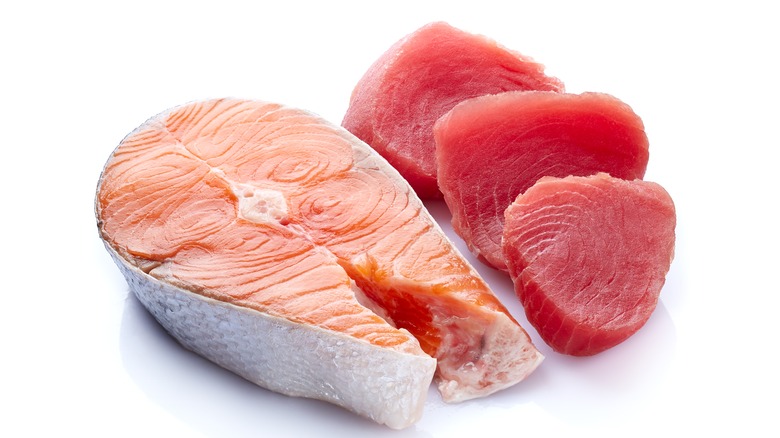Tips For Choosing Between Tuna And Salmon
One of the most popular diets in the world is the Mediterranean Diet. According to Novant Health, one of the key tenants of this diet is eating plenty of oily fish. Fish is a great source of protein and nutrients, and is recommended for regular consumption by the Mayo Clinic. They say the abundance of Omega-3 fatty acids makes fish a great choice to improve heart health. Oily fish like tuna and salmon are both loaded with this nutrient, making them some of the best options available for anyone hoping to improve their heart health without sacrificing flavor.
Tuna and salmon are both among the most popular fish found in grocery stores. They are also some of the highest consumed in the country. The National Fisheries Institute notes that Americans consume more than 1 billion pounds of tuna every year, and salmon falls just behind at more than 900 million pounds every year (via National Geographic). However, there are a few differences between these two fish that are important for anyone seeking to add more fish to their diet.
Nutritional differences
According to Healthline, both of these fish have tons of nutritional benefits. For one, they are both loaded with protein. According to Verywell Fit, salmon and tuna both make great protein sources that contain no carbs or sugars. Tuna takes a slight edge with an average of 21 grams of protein per serving, but salmon doesn't fall far behind. Healthline notes that there's a nutritional difference between farmed and wild salmon, but both tend to have an average protein content in the high teens.
The main difference between the two nutritionally is their fat content (via Healthline). Salmon is a far fattier cut of fish than tuna most of the time, but for the most part, salmon's fat isn't anything to worry about. A large percentage of those fats are from Omega-3 fatty acids that are touted for improving cardiovascular health, per Cleveland Clinic. Both fish contain a good amount of the nutrient, but salmon takes the edge here, according to Healthline.
Tastylicious notes that tuna contains more selenium, which is an important antioxidant. The drawback to tuna is that certain types, such as albacore tuna, are known to contain high levels of mercury. This means that it should be consumed more sparingly to prevent build-up, and that children and pregnant people should limit their tuna consumption, per Healthline. The Food and Drug Administration (FDA) adds that these groups should avoid bigeye tuna altogether.
Culinary differences
When it comes to cooking, the two fish are fairly similar. Both have a stronger, more fishy flavor than your typical white fish like cod (via Healthline). According to Tastylicious, Tuna often has a salty flavor to it most of the time, while salmon is known for its oily taste and soft texture. Both can also be used in a wide variety of dishes. Verywell Fit notes that they're delicious when used for sushi or sashimi, although this should be avoided by pregnant people, young children, older adults, and people with compromised immune systems (per Cleveland Clinic). They can also be roasted, grilled, or served in a salad or pasta dish as well.
The main difference between them when it comes to preparation is their fat contents. Tuna has far less fat than salmon, and because of this, has a tendency to dry out and overcook easily (via Healthline). Its lean nature also means that it tends to hold onto more of the flavors that it is cooked in, notes Verywell Fit. This makes it great for use with sauces and marinades.
Salmon on the other hand is fattier, and is more difficult to overcook. It also has a much flakier texture meaning that it may easily fall apart (via Tastylicious), but can also be shredded for use as a topping or addition when desired.
Prices
For many of us, one of the most important factors to consider is price. Diffen notes that salmon is typically more expensive and is in fact considered a delicacy for many. According to Selina Wamucii, U.S. salmon costs between $2.34 and $2.68 per pound as of 2022. Unfortunately, there is a chance that these prices may continue rising due to the effects of climate change.
Currently, tuna is considered slightly cheaper. Selina Wamucii reports that a pound of tuna in the U.S. costs between $2.28 and $2.24 as of 2022. Tuna will typically be a less expensive option on most menus, and especially canned tuna which is precooked will also usually be marked down (via Miss Vickie). Keep in mind that the Monterey Bay Aquarium Seafood Watch recommends shopping for canned tuna carefully to make sure that you're making an environmentally friendly choice while trying to find an inexpensive option.



